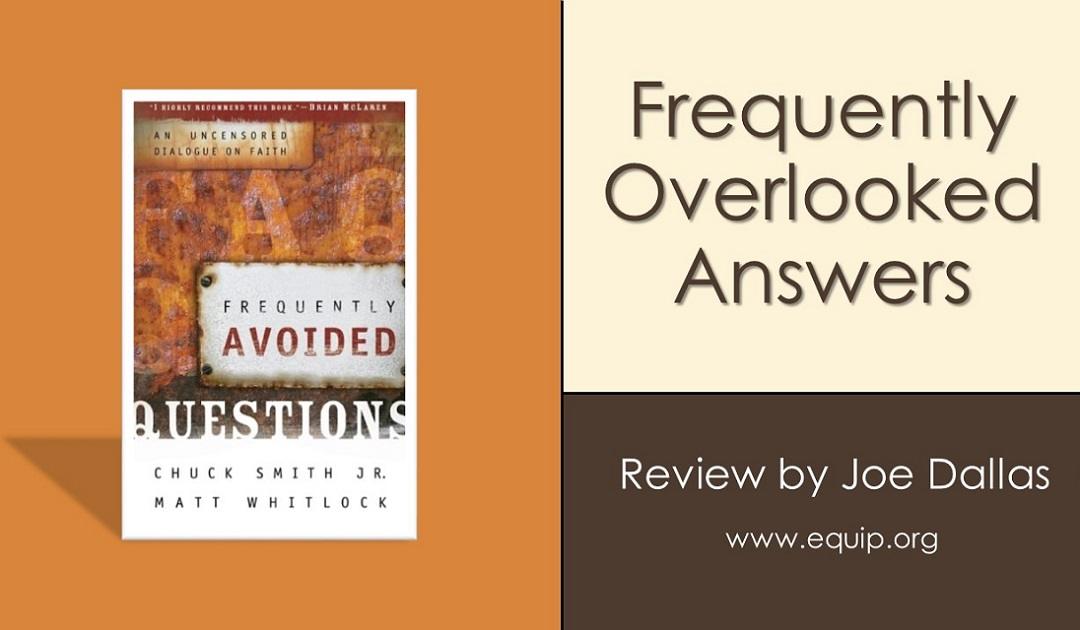This article first appeared in the Christian Research Journal, volume 29, number 06 (2006). For more information about the Christian Research Journal, click here.
The list of titles from “emerging” authors such as Brian McLaren and Donald Miller is lengthy, so the release of yet another book in the same vein is hardly news. Frequently Avoided Questions is noteworthy, however, because one of its authors is the son of pastor Chuck Smith, the highly regarded Bible teacher and founder of the Calvary Chapel movement. Those who are familiar with the doctrinal tensions between the “emerging church” movement and more traditional groups such as Calvary Chapel will be especially interested in whatever contrast there may be between the positions of Chuck Smith, Jr., and his father, and readers of this book will find that contrast firmly in place.
Smith, Jr., and Matt Whitlock (a representative with Youth With A Mission) have a worthy goal in the book: to equip Christians to dialogue about their faith more effectively in a changing, post‐Christian culture. In an engaging format, they offer a point/counterpoint dialogue as they tackle questions about evangelism, requirements for salvation, homosexuality, and the church’s role in society. The book’s title seems presumptuous—these questions have not been avoided, after all; they just have been answered in ways the authors no longer find acceptable—but it never hurts to revisit our approaches to ultimate issues and see how they can be improved.
The authors’ answer to the challenge of ministry in today’s culture is a “new school” approach, one that replaces the “old school” approach that they describe as simplistic and anti‐intellectual. They see the frequent and unexamined use of phrases such as “accept Jesus into your heart” and the tendency to reduce salvation to fire insurance against hell as examples of weaknesses in traditional evangelicals, or “old schoolers.” In contrast, “new schoolers” shun dogma (e.g., “The new school attitude towards absolute truth is that it exists, but no living human being has direct access to it” [135]), emphasize questions more than answers, and presume that the church has been so inept and judgmental that youth has written it off. There is some truth in these criticisms, but they are presented sweepingly, as though all old‐school Christians have been rigid, legalistic, and irrelevant. That is a serious charge, and the authors offer scant evidence to back it other than personal anecdotes and sarcastic asides. (Smith in particular seems to have a chip on his shoulder when discussing his own upbringing in the church, and he takes some rather cheap shots at traditional believers.)
Statements such as “mercy is definitely new school” and “the new school is sensitive to religious hypocrisy” and “new schoolers assume the closer we get to the truth, the more it transforms us” (p. 134), indicate the authors’ assumption that the love of mercy, authenticity, and truth is unique to new schoolers. This rather elitist, arrogant strain is found throughout the book, and no doubt will grate on some readers.
More troubling, though, is the authors’ dismantling of some important foundations, and here a distinction needs to be made between tradition and sound doctrine. Tradition is man made—useful at times, but disposable at others. Jesus thus challenged traditions that were not founded in eternal truth but were revered simply because they had been practiced and accepted over the years. Sound doctrine, however, is God‐given and absolute—a permanent guide for conduct and belief. It is at times laudable to challenge tradition, but not sound doctrine, which must stand firm.
The authors are on the right track in their effort to challenge tradition—traditional clichés, practices, and assumptions ought to be reexamined every so often, either to be renewed or rejected—but as new schoolers they jump track at times by rejecting not only man‐made rules, but God‐ordained doctrine as well. This rejection sometimes comes in the form of ambiguity, especially in the chapter on homosexuality, which leaves the reader without any clear reading of the authors’ position on this behavior. (It should be noted that in other interviews Smith, Jr., has made it clear he is no longer certain that homosexuality is a sin.1)
The most controversial chapters, though, center on the definition of, and qualifications for, salvation. In the authors’ view, “good people” probably go to heaven with or without faith in Christ: “New school believers are asking if it is possible for people who do not know the true Jesus to still be covered by His redemptive work, because He alone knows their hearts” (166). When describing a non‐Christian woman living a commendable life, Smith asks: “What if the way she lives indicates that Jesus is her Lord, even if He is unknown to her?” (159). “It is quite possible,” he also asserts, “that we cannot know if there is a qualitative difference between the Christian and non‐Christian spiritual experience” (138). Such statements indicate a new school questioning of basic Christian doctrine.
It seems to me that therein lies the authors’ greatest error: they have tried so hard to accommodate cultural trends that they have sacrificed truth for emotion. That is a sacrifice I never would have expected these authors to make. — reviewed by Joe Dallas
NOTES
- See “Q and A with Chuck Smith, Jr.,” Dallas Morning News, December 10, 2005, religion section.









